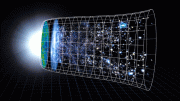
Researchers at UCI and Los Alamos National Laboratory have developed a new method to transform everyday materials into conductors suitable for quantum computing. By manipulating the atomic structure through strain, they have created materials with unique quantum properties, marking a significant advancement towards making quantum computers a practical reality. (Artist’s concept). Credit: SciTechDaily.com
This breakthrough will enable scientists to convert everyday materials into conductors for use in quantum computers.
A recent study by scientists from the University of California, Irvine and Los Alamos National Laboratory, published in Nature Communications, reveals a breakthrough method for transforming everyday materials, such as glass, into materials scientists can use to make quantum computers.
“The materials we made are substances that exhibit unique electrical or quantum properties because of their specific atomic shapes or structures,” said Luis A. Jauregui, professor of physics & astronomy at UCI and lead author of the new paper. “Imagine if we could transform glass, typically considered an insulating material, and convert it into efficient conductors akin to copper. That’s what we’ve done.”
Conventional computers use silicon as a conductor, but silicon has limits. Quantum computers stand to help bypass these limits, and methods like those described in the new study will help quantum computers become an everyday reality.
“This experiment is based on the unique capabilities that we have at UCI for growing high-quality quantum materials. How can we transform these materials that are poor conductors into good conductors?” said Jauregui, who’s also a member of UCI’s Eddleman Quantum Institute. “That’s what we’ve done in this paper. We’ve been applying new techniques to these materials, and we’ve transformed them to being good conductors.”
The Role of Strain in Material Transformation
The key, Jauregui explained, was applying the right kind of strain to materials at the atomic scale. To do this, the team designed a special apparatus called a “bending station” at the machine shop in the UCI School of Physical Sciences that allowed them to apply large strain to change the atomic structure of a material called hafnium pentatelluride from a “trivial” material into a material fit for a quantum computer.
“To create such materials, we need to ‘poke holes’ in the atomic structure,” said Jauregui. “Strain allows us to do that.”
“You can also turn the atomic structure change on or off by controlling the strain, which is useful if you want to create an on-off switch for the material in a quantum computer in the future,” said Jinyu Liu, who is the first author of the paper and a postdoctoral scholar working with Jauregui.
“I am pleased by the way theoretical simulations offer profound insights into experimental observations, thereby accelerating the discovery of methods for controlling the quantum states of novel materials,” said co-author Ruqian Wu, professor of physics and Associate Director of the UCI Center for Complex and Active Materials – a National Science Foundation Materials Research Science and Engineering Center (MRSEC). “This underscores the success of collaborative efforts involving diverse expertise in frontier research.”
“I’m excited that our team was able to show that these elusive and much-sought-after material states can be made,” said Michael Pettes, study co-author and scientist with the Center for Integrated Nanotechnologies at Los Alamos National Laboratory. “This is promising for the development of quantum devices, and the methodology we demonstrate is compatible for experimentation on other quantum materials as well.”
Right now, quantum computers only exist in a few places, such as in the offices of companies like IBM, Google, and Rigetti. “Google, IBM, and many other companies are looking for effective quantum computers that we can use in our daily lives,” said Jauregui. “Our hope is that this new research helps make the promise of quantum computers more of a reality.”
Reference: “Controllable strain-driven topological phase transition and dominant surface-state transport in HfTe5” by Jinyu Liu, Yinong Zhou, Sebastian Yepez Rodriguez, Matthew A. Delmont, Robert A. Welser, Triet Ho, Nicholas Sirica, Kaleb McClure, Paolo Vilmercati, Joseph W. Ziller, Norman Mannella, Javier D. Sanchez-Yamagishi, Michael T. Pettes, Ruqian Wu and Luis A. Jauregui, 6 January 2024, Nature Communications.
DOI: 10.1038/s41467-023-44547-7
Funding came from the UCI-MRSEC – an NSF CAREER grant to Jauregui and Los Alamos National Laboratory Directed Research and Development Directed Research program funds.
UCI graduate and undergraduate students, including Robert Welser, Sebastian Yepez Rodriguez, Matthew Delmont, and Triet Ho, participated in this study.








You are pleased by the way theoretical simulations offer profound insights into experimental observations, thereby accelerating the discovery of methods for controlling the quantum states of novel materials.
Only with correct theory can simulate scientifically. Wishing you all the best.
The universe does not do algebra, formula or fraction. The universe is geometrythe, and is the superposition, deflection, and twisting of geometric shapes.
Today, we have already entered the era of the internet. With the help of artificial intelligence and big data, discussions on scientific knowledge have become open and transparent. However, a group of editors of so-called academic journals (such as Physical Review Letters, Nature, Science, etc.) are self-righteous and mystifying themselves. They only care about their own so-called sufficiently high priority rating, general significance, discipline, novelty, etc., and do not care about what science and pseudoscience are.
Science and pseudoscience are not determined by a publication, an organization or a person, nor by you or me, but by mathematics the final say. Physical models must be based on mathematics or mathematical models in order to be scientific, convincing, and in accordance with natural laws.
The origin of geometry lies in the concerns of everyday life. The branch of geometry (mathematics) known as topology has become a cornerstone of modern physics. Topological vortex and antivortex are two bidirectional coupled continuous chaotic systems. They exhibit parity conservation, charge conjugation, and time reversal symmetry. The synchronization effect is extremely important in their interactions. The synchronization effect of the superposition, deflection, and twisting of multiple or countless topological vortices will make spacetime motion more complex. To understand this complex world, physics should respect the authenticity of topological vortex in low dimensional spacetime, rather than simply relying on a few formulas, numbers, or imagined particles.
Spin is a natural property of topological vortices. Spin is synchronized with energy, spin is synchronized with gravitation, spin is synchronized with time, spin is synchronized with evolution. The perpetually swirling topological vortices defy traditional physics’ expectations. One physical properties of topological vortices is them to spontaneously begin to change periodically in time, even though the system does not experience corresponding periodic interference. Therefore, in the interaction of topological vortices, time is both absolute and relative,and physics often requires treating space and time at the same level.
Low-dimensional spacetime matter is the foundation of high-dimensional spacetime matter. Low-dimensional spacetime matter (such as topological vortex) can form new material structures and derive more complex physical properties via interactions and self-organization. It is extremely wrong and irresponsible to imagine low dimensional spacetime matter using high-dimensional spacetime matter,such as a cat in quantum mechanics.
Science must follow mathematical rules. For example, the Standard Model (SM) is considered to be one of the most significant achievements of physics in the 20th century. However, the magnetic moment of μ particle is larger than expected, revealed by a g-2 experiment at Fermilab, suggests that the established theory (such as SM) of fundamental particles is incomplete. Furthermore, the SM omitting gravitation, it not involved the time problem and when the particle movement starts. Mathematics is the foundation of science. Physics must respect the scientific nature of mathematics and mathematical models. The SM must be based on mathematical models in order to be scientific, convincing, and in line with natural laws.
I hope researchers are not fooled by the pseudoscientific theories of the Physical Review Letters (PRL), and hope more people dare to stand up and fight against rampant pseudoscience.
The so-called academic journals (such as Physical Review Letters, Nature, Science, etc.) firmly believe that two high-dimensional spacetime objects (such as two sets of cobalt-60) rotating in opposite directions can be transformed into two objects that mirror each other, is a typical case of pseudoscience rampant.
If researchers are really interested in Science and Physics, you can browse https://zhuanlan.zhihu.com/p/643404671 and https://zhuanlan.zhihu.com/p/595280873.
I am well aware that my relentless repetition can make some people unhappy, but in the fight against rampant pseudoscience, that’s all I can do.
First my apologies. Certain materials like iron telluride or hafnium telluride are elusive materials with magical properties to use in spintronics or with strain in certain materials to become super conductors for applications in quantum computing . This is part of real science not pseudo science . My apologies once again if my comment is offensive.
Congratulations!
Your understanding is very thorough. There are actually many elusive materials. Even for topological vortices, the direction of rotation is uncertain when observed. Before you observe it, there is a possibility of both left-hand or right-hand rotation. The observation result depends not only on the rotation of the vortex, but also on the position (such as in front or behind the vortex) of the observer.
Please think,
1. Why do electrons spin?
2. Who gave the electron spin power?
3. Is spintronics related to the spin of 2D topological vortices?
4. Are electrons 2D?
5. Why do galaxies and stars in the universe spin?
6. Where do the forces of galaxy and star spin in the universe come from?
7. Can the symmetric spin of topological vortices be transformed into force?
and so on.
There’s a kind of glass that these researchers might want to look at. When the most powerful lightning bolts hit the sand of Florida beaches, it creates these crystal ball-like glass spheres. Most lightning hitting the grounds creates fulgerites, fused glass structures resembling dirty ceramic tree roots, but the most powerful lightning bolts striking sand, create these clear glass orbs, and because this is a very unique type of glass, perhaps if they checked it in their quantum labs, they could discover something useful in this field of research.